
Harmondsworth is a village in the London Borough of Hillingdon in the county of Greater London with a short border to the south onto London Heathrow Airport and close to the Berkshire county border. The village has no railway stations, but adjoins the M4 motorway and the A4 road. Harmondsworth was in the historic county of Middlesex until 1965. It is an ancient parish that once included the large hamlets of Heathrow, Longford and Sipson. Longford and Sipson have modern signposts and facilities as separate villages, remaining to a degree interdependent such as for schooling. The Great Barn and parish church are medieval buildings in the village. The largest proportion of land in commercial use is related to air transport and hospitality. The village includes public parkland with footpaths and abuts the River Colne and biodiverse land in its Regional Park to the west, once the grazing meadows and woodlands used for hogs of Colnbrook.

George Edward Stanhope Molyneux Herbert, 5th Earl of Carnarvon,, styled Lord Porchester until 1890, was an English peer and aristocrat best known as the financial backer of the search for and excavation of Tutankhamun's tomb in the Valley of the Kings.
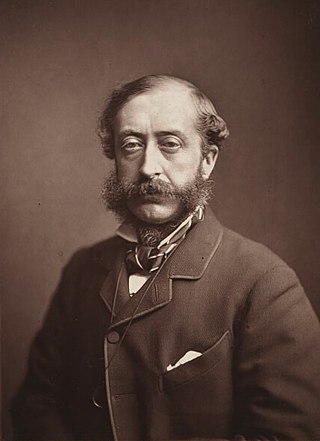
Henry Howard Molyneux Herbert, 4th Earl of Carnarvon,, known as Lord Porchester from 1833 to 1849, was a British politician and a leading member of the Conservative Party. He was twice Secretary of State for the Colonies and also served as Lord Lieutenant of Ireland.

Earl of Carnarvon is a title that has been created three times in British history. The current holder is George Herbert, 8th Earl of Carnarvon. The town and county in Wales to which the title refers are historically spelled Caernarfon, having been Anglicised to Carnarvon or Caernarvon. The traditional Welsh spelling is itself a modified form of the original name of antiquity, Caer-yn-Arfon, meaning fortification opposite the island of Mona.

Henry George Reginald Molyneux Herbert, 7th Earl of Carnarvon, , was a British peer and racing manager to Queen Elizabeth II from 1969. From his birth until September 1987, he was known by the courtesy title Lord Porchester.
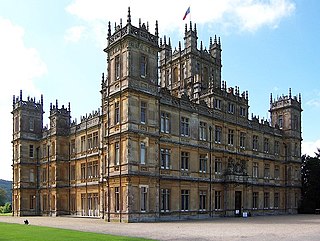
Highclere Castle is a Grade I listed country house built in 1679 and largely renovated in the 1840s, with a park designed by Capability Brown in the 18th century. The 5,000-acre (2,000 ha) estate is in Highclere in Hampshire, England, about 5 miles (8 km) south of Newbury, Berkshire, and 9.5 miles (15 km) north of Andover, Hampshire. It is the country seat of the Earls of Carnarvon, a branch of the Anglo-Welsh Herbert family.

North West Hampshire is a constituency represented in the House of Commons of the UK Parliament since 2015 by Conservative Kit Malthouse, who served as Education Secretary in 2022.
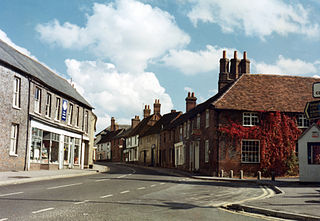
Kingsclere is a large village and civil parish in Hampshire, England.
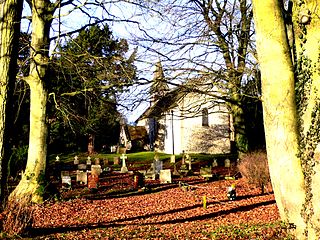
Litchfield is a village and former civil parish, now in the parish of Litchfield and Woodcott, in the Basingstoke and Deane district of Hampshire, England. It is closely bypassed by the A34 trunk road between Newbury and Whitchurch, which follows the course of the former Didcot, Newbury and Southampton Railway. Litchfield railway station, which closed in 1960, was on this line. The station is a private house, not owned by C.A.H Wills who owns Litchfield farms estate and lives in the village. The station was sold by Hampshire County Council in 1978 and has been restored. The approach road is now a private drive to the property. In 1976 the Litchfield - Whitchurch bypass was opened and made use of the DN&SR trackbed south of Litchfield towards Whitchurch for a distance of one mile. In 1931 the parish had a population of 88.
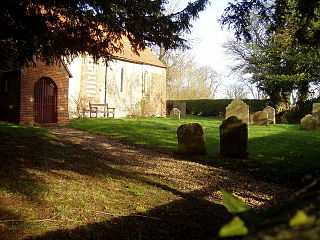
Ashmansworth is a village and civil parish in the Basingstoke and Deane district of the English county of Hampshire.

Highclere is a village and civil parish situated in the North Wessex Downs in the Basingstoke and Deane district of Hampshire, England. It lies in the northern part of the county, near the Berkshire border. It is most famous for being the location of Highclere Castle, a noted Victorian house of the Earl of Carnarvon. It is the setting for numerous films and TV series, including Downton Abbey.

Newtown is a village and civil parish in the English county of Hampshire, about 1+1⁄2 miles (2.4 km) south of Newbury, Berkshire.

Teversal is a village and former civil parish, now in the unparished area of Sutton in Ashfield, in the Ashfield district of Nottinghamshire, England, 3 miles (5 km) west of Mansfield, close to Sutton-in-Ashfield and the boundary with Derbyshire. Former names include Tevershalt, Teversholt, Tyversholtee, Teversale, Tevershall and Teversall. In 1931 the parish had a population of 946.
This is a list of places of interest in the ceremonial county of Hampshire, England. See List of places in Hampshire for a list of settlements in the county.

Sandleford is a hamlet and former parish in the English county of Berkshire. Since at least 1924, the settlement has been within the civil parish of Greenham, and is located approximately 1.5 miles (2.4 km) south of the town of Newbury.

Winslade is a hamlet and civil parish in the Basingstoke and Deane district of Hampshire, England. It lies 3 miles (4.8 km) south of Basingstoke, just off the A339 road. The hamlet covers an area of 712 acres (288 ha) and has an average elevation of 550 feet (170 m). Its nearest railway station is Basingstoke, 4.2 miles (6.8 km) north of the hamlet. The parish of Winslade contains the vast Hackwood Park, an 89-acre (36 ha) Grade I listed Royal deer park. According to the 2011 census, Winslade, along with Tunworth, Weston Corbett and Weston Patrick, had a population of 224.

Newtown Common is a village in the Basingstoke and Deane district of Hampshire, England. Its nearest town is Newbury, which lies approximately 2.5 miles (4.1 km) north-east from the village.

Sydmonton is a small village, estate and former civil parish, now in the parish of Ecchinswell, Sydmonton and Bishops Green, in the Basingstoke and Deane district of Hampshire, England. Its nearest town is Newbury, which lies approximately 7 miles (11 km) north-west from the village. In 1931 the parish had a population of 139.

Sandleford Priory was a small Augustinian Priory, the remains of which now stand at Sandleford in the civil parish of Greenham in the English county of Berkshire.

St Lawrence's Church is a Grade II listed sacred edifice in Ecchinswell, Hampshire, England, in the rural deanery of Whitchurch, within the Diocese of Winchester, designed by Bodley & Garner, 1885–87, at a time when Ninian Comper was their articled pupil, 1883-1887. It has 200 sittings.


























